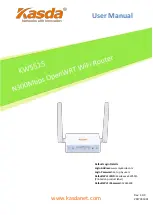
57
Status information
Device
u
System time
System time of the device.
u
Firmware version
Firmware version currently installed on the device.
ì
Click
Refresh
to refresh this screen and update the displayed data.
Security
You will find information about possible security risks for the device and the network on
the
Security
screen in the
Status
menu.
In the
Status
menu, select
Security
:
u
System password not changed
The configuration program of the device is not sufficiently protected against unau-
thorised access because you have not changed the system password since setting up
the device. Information on how to avoid this security risk is given in the section "Sys-
tem Password" on page 50.
u
Identification of your wireless network visible or not changed
Unauthorised users can also find the wireless network easily as you have not
changed the ID of the wireless network (SSID) since setup and have not deactivated
SSID broadcasting. Information on how to avoid this security risk is given in the sec-
tion "Configuring wireless connections" on page 39.
u
Encryption for your wireless network not activated
None of the data in the wireless network is encrypted during transfer and can there-
fore easily be intercepted. Unauthorised users will also have easy access to your net-
work, your PCs and your Internet connection. Information on how to avoid this secu-
rity risk is given in the section "Setting encryption" on page 41.
u
Access to your wireless network not restricted to allowed clients
Users can access the wireless network from any PC. Information on how to avoid this
security risk is given in the section "Permitted clients" on page 45.
u
Firewall for your Internet connection turned off
The network is not protected against hackers who gain unauthorised access via the
Internet. Information on how to avoid this security risk is given in the section "Fire-
wall" on page 28.
u
Address translation for your Internet connection turned off
The clients in the network are not protected against unauthorised access via the
Internet. Information on how to avoid this security risk is given in the section "Set-
ting up the NAT function" on page 30.
u
One or more of your local clients directly exposed to the Internet
At least one client in the network is directly visible on the Internet as an exposed host
and is therefore particularly exposed to the risk (e.g. through hacker attacks). Only
activate this function if it is absolutely necessary (e.g. to operate a Web server) and
















































